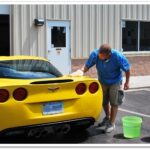The 1le Camaro. Just the name itself evokes images of roaring engines, blistering track times, and unparalleled cornering prowess. Having spent some quality time behind the wheel of this performance machine, albeit for a brief 400 miles before an unfortunate incident, I can attest to the sheer thrill and capability it offers. The cornering grip is truly something to behold, transforming any winding road into your personal racetrack. However, like any specialized tool, the 1LE Camaro comes with its own set of considerations that potential owners should be aware of.
One of the first things you’ll notice, visually, is the stance. Unlike the ZL1 with its wide, muscular fenders, the 1LE Camaro, while sporting the same formidable tires, has them sitting slightly proud of the wheel well lips. This seemingly minor detail has a significant impact on paint protection. Prepare for a barrage of road debris – gravel, sand, and anything else loose on the asphalt – to be flung upwards, relentlessly attacking your paintwork. Even with protective film like Xpel, evidence of chipping was clearly visible on my car after limited driving. Venture onto any gravel road, and you’re essentially sandblasting your lower panels.
Speaking of tires, be prepared for a potentially frequent replacement cycle. My 1LE Camaro, acquired with just under 10,000 miles on the odometer, was already in need of new rubber. The original Goodyear tires were completely worn out. While tire longevity can vary based on driving style and conditions, a 10,000-mile lifespan for a set of $1300 tires seems to be a realistic expectation for spirited drivers. Some may claim to get more miles, but real-world experience suggests this is not always the case, especially if you’re using the car as intended – carving canyons and pushing its limits. While the cost might seem steep, it’s worth noting that performance tires with comparable grip levels often come with a similar or even higher price tag, making the Goodyears a reasonable value proposition for the performance they deliver. However, a crucial word of caution: these tires are not designed for cold weather. Driving in temperatures below 40 degrees Fahrenheit can lead to tire cracking, posing a significant safety risk.
Rainy conditions demand extreme caution when driving the 1LE Camaro with any enthusiasm. On-ramps, typically a playground for performance cars, become treacherous in the wet. Resist the temptation to accelerate aggressively, as the electronic traction control, while present, is not a foolproof safety net in these conditions. The 1LE’s focus on track performance translates to a less forgiving experience in low-grip situations.
Maintaining the 1LE Camaro also comes with specific considerations. The engine oil reservoir is notably large, leading to higher servicing costs, particularly at dealerships. Oil changes can become a surprisingly expensive routine maintenance item.
To truly unlock the 1LE Camaro’s legendary track prowess, a performance wheel alignment is practically mandatory. This specialized alignment, typically costing around $80, optimizes the car for cornering grip at the expense of tire wear. While enhancing handling, it further reduces tire lifespan compared to a standard street alignment.
When considering trim levels, the 1SS 1LE and 2SS 1LE offer different feature sets. Initially, opting for the base 1SS trim meant sacrificing some comfort and convenience options available on the 2SS. While a 2SS 1LE is now available, the added weight of these features inevitably impacts overall performance, especially in a track-focused context. Purists seeking the ultimate 1LE experience for road course domination might still prefer the lighter, more stripped-down 1SS variant. A direct performance comparison between 1SS and 2SS 1LE models on a track would be insightful, but anecdotal evidence suggests the weight difference does have a tangible effect.
Interestingly, straight-line acceleration is not where the 1LE Camaro shines brightest, at least not in standard form. An 8-speed automatic Camaro 1SS will likely outpace a 1LE from a standstill and in a drag race. Therefore, if drag strip dominance is your primary performance metric, the 1LE might not be the ideal choice. Its launch characteristics, while improved over base models, are not optimized for drag racing.
Despite these drawbacks, which are largely inherent to its focused design, the 1LE Camaro remains an exceptional performance car. Even with its “modest” 455 horsepower, it delivers a driving experience that is incredibly difficult to match, especially at its price point. For its intended purpose – conquering road courses and providing thrilling driving dynamics – the Camaro 1LE is arguably in a class of its own. It even comes remarkably close to the performance envelope of the Ford Mustang GT350R, a car that commands a significantly higher price tag, often exceeding the 1LE by $20,000 or more. In the realm of bang-for-your-buck track performance, the 1LE Camaro makes a compelling and ultimately victorious statement.
